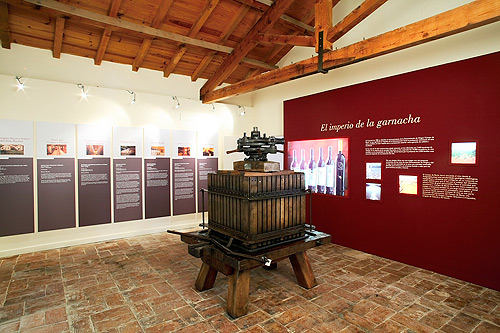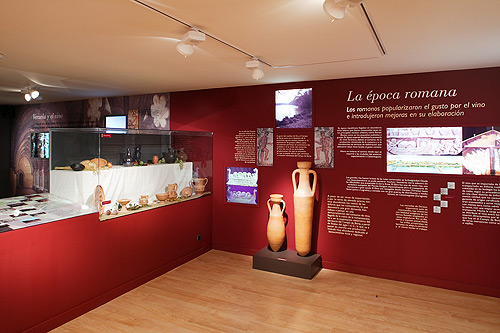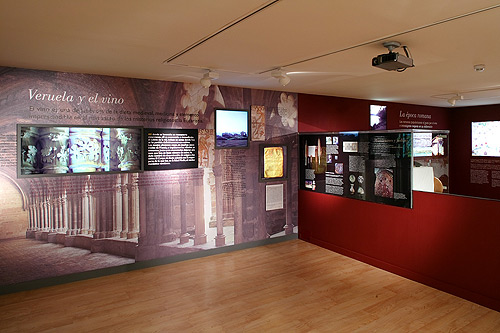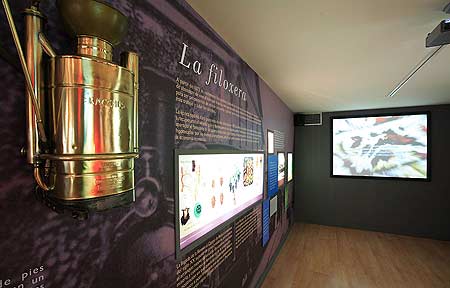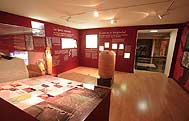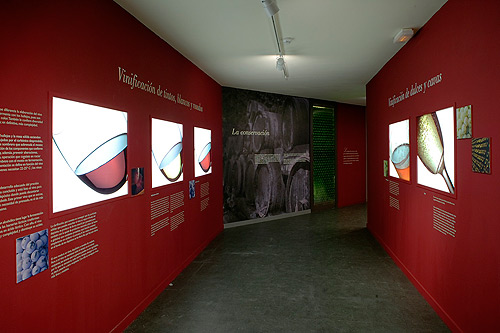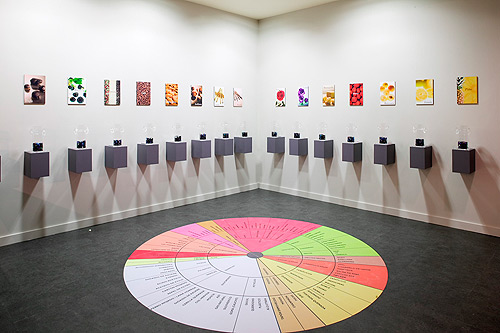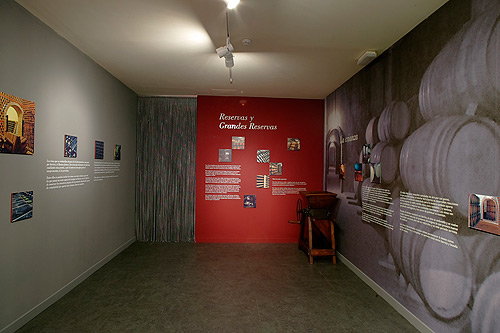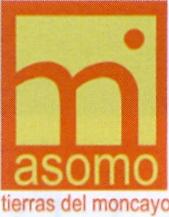WINE MUSEUM
Opening hours and schedule
From October to March: 10:30h. A 18:00h.
From April de September: 10:30h a 20:00h.
Closed: Tuesdays (except bank holidays), 25 December and 1 January.
Wine Museum Visit: Free entrance visiting Monastery
Visit to the Monastery of Veruela
1,80 €/persona
Groups (26 people): 1,20€/person
pensioners: 0,60 €/person
Set up in the Cistercian Monastery of Veruela at the foot of the Moncayo mountain, the Campo de Borja Wine Museum opened its doors to the public in September 1994. It is one of the pioneers in Spain and the first of its kind in Aragon.
It was created with the spirit of serving the Denomination of Origin, making it known to the thousands of visitors that travel the Moncayo Lands and transmitting its resources as a top quality wine-tourism instrument.
It is the starting point to discover our wines and wineries, as well as the rest of the area around us, such as the Nature Park of Moncayo, the Monastery of Veruela, the cities of Borja and Tarazona with their monuments as well as the many picturesque villages.
Discovering the Wine Museum and the Campo de Borja wines means tasting the flavour and magnetism of the Moncayo, penetrating into an intense and rich universe. Welcome to the Wine Museum, discover your sixth sense.
Ground Floor
Tasting Rooms
Equipped with individual tasting positions, visitors will be able to follow courses on oenology and vine-growing. Discover the secrets of wine in the Tasting Initiation courses that are delivered in this space.
Winery Room
The visit to the Wine Museum begins in the Winery Room, where visitors will find information about the 17 entities that are protected by this denomination of origin and which can you situate on the map enclosed with this leaflet.
D.O Room
Then in the Auditorium, a room that used to be part of the former museum, a video is shown presenting the Moncayo Lands, a territory of legends.
History Area
Wine is Life
From just a small seed, the vine and its fruit shoot up, a magical process that you can experience through the “vine is life” audiovisual.
History, Art and Wine. The Inheritance of the Moncay
The History Area, divided into three traditional phases: Ancient, Middle Ages, Modern and Contemporary, shows the main historical and artistic expressions of the vineyard cultivation and the preparation of wine, placing emphasis on the vine-growing culture of Campo de Borja throughout history: from the time the Celtiberians heard of it, from the importance of the Monastery of Veruela in the expansion of the vineyard in the area, to the creation of small hill wineries, the 20th century cooperativism and the recognition as a Denomination of Origin in 1980.
Vine-Growing and Oenology Area
From the stock to the glass
Varieties and Morphology of Wine
The majestic Moncayo mountain rises up like an eternal watchtower over these lands and a modulator of our climate; the essence of the unique character of our vineyards and our grape, the Garnacha.
The Vine Cycle
Work in the vineyards throughout the year is shown in 4 videos where the vegetative phenomena such as the “lloro” (bleeding), the flowering of the vine, its maturing and the harvest are narrated via rich images.
La vendimia
Es el momento de recoger los frutos de un largo y minucioso trabajo de forma manual o mecanizada.
The Transport. The Crushing.
To illustrate this phase the visitor can observe a model of the “Borjica” Train or “Escachamatas”, which transports the grape and wine from Borja to Cortes in Navarra, from where it is distributed to the north of Spain.
The Chof
Once the grapes reach the wineries, the virtual treading takes place via a film that simulates a press on the floor, so that visitors transform the grape into wine whilst they cross this space.
The Garnachica Show
This complex transformation is explained in a humorous manner by cartoon characters in a mini-film, called “Vino el vino” (the wine came), where Don Tanino (Mr. Tanine), Doña Estudis (Mrs. Estudis) and Don Tartrato (Mr. Tartrate) will teach “Garnachica”, the museum’s kids’ mascot, the main secrets about transforming grapes into wine.
Work in the Winery
In a more traditional manner, by way of texts and images, an explanation is given of the work in the winery to obtain young, crianza and reserva wines.
Vinification
The must contained in the pulp of the grapes starts the fermentation process offering us the first wine, which will be treated traditionally until well structured wines with character are obtained..
The Virtual Theatre
After the wines have been prepared it is time to examine its characteristics in the Virtual Theatre, where our virtual three-dimensional characters – a Cistercian monk from the Middle Ages and an oenologist from the 21st century – will share their peculiar vision of the wine with the guests.
THE WORKSHOP OF SENSES
An original space that tests the sensitivity of each person showing the subtleties and nuances of the wine through their sensorial perceptions. We invite you to discover the keys of a Professional Tasting step by step.
The Wine Colours
Vibrant and intense pigments tinge this room devoted to colour, which illustrates how the varied chromatism of nature is transferred to wine in each one of its tones.
The Wine Aromas
Smell is now the sense that becomes all important. 16 spice racks enable visitors to play at perceiving some of the aromas present in wine. Vanilla, cinnamon, pepper… and you? what aromas do you perceive?
The Wine Textures
The taste and touch of wine have been united in a small space where the rule is to touch and feel four of the different textures that can be distinguished when tasting wine. You will also be given a brief vision of the phases of Wine-tasting and some of the keys about the marriage of wine and gastronomy, when the former is understood as food and an essential part of the Mediterranean diet.
REGULATORY COUNCIL OF THE D.O. CAMPO DE BORJA
C/ Subida de San Andrés, 6 C/P 50570 - AINZÓN - ZARAGOZA
vinos@docampodeborja.com
Tel. 976 85 21 22 / Fax 976 86 88 06
Legal notice | Privacy policy | Cookies policy | Documentation| Norma 17065
Web design: www.radicarium.com


